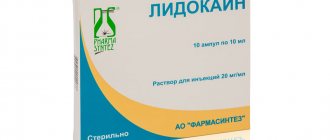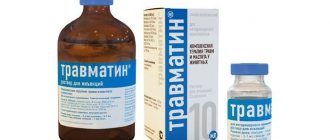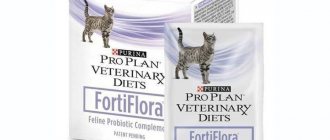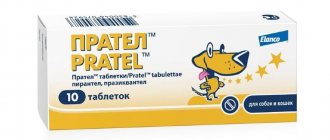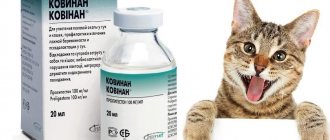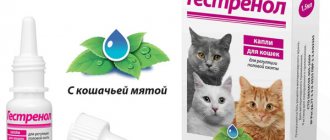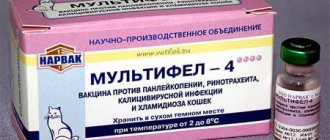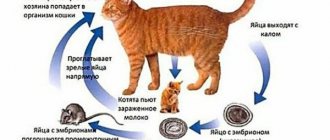Farmazin for cats is an antibacterial drug used in veterinary medicine to treat diseases of a bacterial nature.
Indications for the use of Farmazin include pneumonia, furunculosis, chlamydia, mycoplasmosis, arthritis, purulent mastitis. This is a solution for intramuscular injection.
Properties, principle of operation
A broad-spectrum antibiotic is prescribed for the treatment of bacterial lesions only if there are no contraindications for the use of the composition.
Farmazin for cats
It is unacceptable to violate the course of therapy, as this leads to the formation of bacteria resistant to Farmazin, which significantly complicates further treatment. The composition is effective against most gram-positive and gram-negative bacteria (spp).
The main component of the drug, tylosin, has an inhibitory effect on protein synthesis in bacterial cells.
This allows you to stop the reproduction of the pathogen in a short time and destroy it with minimal harm to the animal’s body. The effect of tylosin is pronounced. The active components of the drug quickly penetrate the blood after its administration and are distributed throughout the body.
The maximum concentration of the antibiotic during accumulation is achieved in the lungs, kidneys and liver. The medicine is excreted in urine and feces.
If, after 3 days from the start of treatment, the animal’s condition does not improve, then it is necessary to urgently visit a veterinarian.
It is highly likely that the medication will need to be replaced with another drug. If possible, to determine the effectiveness of Farmazin, a bacterial culture of a smear taken from the throat or nose during inflammation of the respiratory system is carried out on a nutrient medium.
Be sure to read:
Prednisolone for cats: indications, dosage, instructions for use for different forms
When to use
Farmazin 200 fights streptococci, staphylococci, mycoplasma, chlamydia. It is most often used for bronchopneumonia in goats, sheep, pigs, as well as pets - cats, dogs.
Other indications:
- enzootic pneumonia;
- infectious agalactia;
- atrophic rhinitis;
- as well as arthritis;
- dysentery;
- mastitis;
- some infections of the epidermis.
In addition, Farmazin 200 is prescribed for infections secondary to viral diseases (both for treatment and prevention).
For diseases of poultry, another form of release of this drug is often used, using Farmazin not 200, but 500, which is produced in the form of a water-soluble powder. It is diluted in water and given to birds and animals as a drink.
Attention! During the entire period of treatment, ordinary drinking water should be replaced with that in which the medicine is dissolved. The sick bird or animal is not given any other drink during the entire healing period.
Indications for use
For cats, the medicine is used according to strict indications.
Your veterinarian may prescribe an antibiotic for your cat in the following cases:
- bronchopneumonia, especially in advanced form;
- severe inflammation of the joints of a bacterial nature;
- dysentery;
- secondary bacterial infection against the background of a viral infection;
- severe purulent-inflammatory skin diseases, if there is no effectiveness from the use of other types of antibiotics.
In most cases, Farmazin 50 is prescribed to cats by a veterinarian when the use of other types of antibiotics is low.
The main area of use of this antibiotic is agriculture , where it allows you to quickly eliminate various diseases of pigs, goats, sheep, cows and poultry. With this treatment, it is possible to consume their meat, milk and eggs fairly quickly after its completion.
Farmazin 1000
The drug is produced in the form of granules, packaged in 1.1 kg bags. 1 g contains 1000 units. tylosin. The cost of packaging in September 2021 is 8820 rubles.
The drug is used to treat intestinal and respiratory infections at a dose of 0.5 g/l for birds and 0.25 g/dm3 for pigs. The drinking time for birds is 3–5; pigs 3–10 days.
Farmazin 1000 is used to prevent mycoplasmosis in chickens and infectious sinusitis in turkeys. The regimen is the same as when using Farmazin 500, the amount of the drug is 0.5 g/l.
The waiting period for poultry and pig meat is 5 days. The granules are stored for 3 years at temperatures from 5 to 25 °C.
Directions for use, dosage for cats
The medicine is administered through an injection. The injection is given intramuscularly in the thigh using an insulin syringe. The dose for the animal is individually calculated by the veterinarian.
Most often, an antibiotic is administered at a dosage of 0.1-0.2 ml per 1 kg of cat weight per day. The injection is given once a day at the same time. The drug should be injected alternately into the right and left thigh. This is required to prevent the formation of compactions in tissues.
The medicine is administered by injection
The course of treatment is determined by a veterinarian and should not be interrupted arbitrarily by the cat’s owner.
After the animal’s condition improves, the prescribed course of injections is continued for as many days as recommended by the veterinarian. Otherwise, there is a high risk of re-development of the disease due to activation of the pathogen.
Farmazin 500 water-soluble
A cream-colored powder containing 50% tylosin is packaged in foil bags or jars of 200 g.
Cost in September 2021 - 1050 rub.
The drug is prescribed for the prevention and treatment of respiratory diseases in birds and calves, as well as intestinal infections in pigs. Farmazin is used for monogastric patients as the only source of drink in accordance with the scheme:
| Kind of animal | Mode of application | Dosage | Duration of treatment, days |
| Bird | Group | 1 g/l water | 3–5 |
| Pigs | 0.25–0.5 g/l water | 3–5 | |
| Calves | Individual | 1 g dissolved in a liter of milk or water twice a day | 7–14 |
Farmazin 500 is used for the prevention of respiratory mycoplasmosis in chickens, as well as infectious sinusitis in turkeys in a therapeutic dose during the following periods of life:
| Bird | Days of life |
| Breeding chickens | 1–5; 28–29; 56–57; 140–141 |
| Replacement pullets, turkeys, broiler chickens | 1–3; 28–29 |
The penalty period for veal is 14 days, for pork and poultry meat - 5 days. The drug is stored for 3 years at temperatures from 5 to 25 °C.
Contraindications and possible side effects
Side effects are rare if the dosage of the medication is followed. In some cases, it is possible to develop an allergy to the drug. Treatment is symptomatic.
Contraindications to the use of the composition are as follows:
- individual intolerance to the drug or hypersensitivity to it;
- use of other antibiotics;
- kitten feeding period.
Be sure to read:
How and when should Lincomycin be used for cats: instructions, dosage and reviews
Pregnant cats are prescribed medication only if there is no other treatment that is safe for the offspring.
When is Farmazin used?
Farmazin 50 is used to treat:
— bronchopneumonia of large and small cattle, pigs, dogs and cats;
— mastitis in cattle;
— enzootic pneumonia, arthritis, dysentery, atrophic rhinitis of pigs;
— infectious agalactia of sheep and goats;
- skin infections.
— secondary infections in viral diseases.
is not recommended due to a pronounced decrease in the antibacterial effect of tylosin.
Reviews from owners and veterinarians about the drug
Veterinarians speak positively about the medicine, but since it is more intended for farm animals, they do not use it for cats very often.
Cat owners, although the antibiotic has a quick therapeutic effect, usually do not really like it when their pets are prescribed this composition, since they have to give intramuscular injections.
Those who know how to easily administer medicine intramuscularly to a cat speak only positively about the product.
pharmachologic effect
Farmazin 50 and Farmazin 200 are available for sale. The drugs differ from each other in the concentration of the active substance - tizolin. It neutralizes staphylococci, corynebacteria, streptococci, treponema and mycoplasma. The injection solution is injected into the muscle area (usually the thigh). It is characterized by rapid absorption and penetration into the tissues of vital organs. Tizolin remains in the tissues of the animal’s organs and blood for up to 24 hours, after which it is evacuated from the body along with feces and partly with urine. Like any antibiotic, Farmazin destroys not only harmful, but also healthy microflora, so this drug is prescribed in case of emergency. Farmazin and other antibacterial drugs are not prophylactic agents.
Dosage
A single dose of Farmazin is calculated depending on the physical characteristics of the animal. The recommended dosage of the solution for injection is prescribed in the instructions. The exact volume of the drug administered intramuscularly and the duration of the course of treatment should be discussed with your veterinarian. It is not permissible to interrupt the course of treatment if no adverse reactions occur from the animal’s body. If Farmazin is discontinued on its own, the therapeutic effect is reduced. In case of an overdose of Farmazin, the animal experiences dyspeptic disorders and apathy. There may be a disturbance in the intestinal microflora, manifested by diarrhea, the presence of undigested food in the stool, and bloating. If signs of allergy are observed after administration of the drug, the drug is immediately discontinued and the cat is given an antihistamine.
Properties and pharmacodynamics
Catosal contains phosphorus-containing compounds. Thanks to its balanced biochemical composition, the drug increases the resistance of the animal’s body, activates immune defense, and replenishes the lack of nutrients, vitamins, proteins, minerals, fats, and essential amino acids.
The drug Catozal normalizes protein, lipid, and carbohydrate metabolism in the body of warm-blooded animals. The active substances of the stimulating medicine promote the growth and development of young cattle, fur-bearing animals, cats, and dogs.
Catozal is prescribed to small kittens for growth, development, and strengthening the immune system.
Catozal has tonic properties and has a beneficial effect on internal organs and body systems.
Storage conditions
The properties of the medicine are neutralized when stored at temperatures above 25 degrees and intense exposure to the sun. The sales period is 3 years from the production date. Opened containers are stored for up to 4 weeks. If the integrity of the bottle is damaged, the drug is discarded. Farmazin is easily tolerated by animals, and if the treatment regimen is followed, it completely cures ailments of a bacterial nature. The advantages of a pharmacological product include an affordable price and a quick effect.
Attention: any drug from this group of pharmacological products is prescribed after receiving the results of an analysis of the cat’s blood, urine and excrement to determine the causative agent of the disease! An incorrectly prescribed antibiotic will be useless at best, and will harm the cat’s health at worst.
Subcutaneous injection for a cat
Visit the profile section of our Medical Examination forum or leave your feedback in the comments below. More opinions means more useful information, it will be useful to someone. If there are good and interesting videos on the topic of the article, write and I will insert them into this publication.
special instructions
The use of the drug requires compliance with the following rules and regulations:
- Poultry should be slaughtered for meat 5 days after stopping the medication. If this norm is not observed, the meat should be used for preparing meat and bone meal or as feed for carnivorous animals.
- When working with Farmazin-500, it is forbidden to eat, smoke or drink.
- Do not use empty medicine containers for household needs.
- Follow safety and personal hygiene rules.
Price of Farmazin and its analogues
The price of Farmazin in powder form for preparing an injection solution ranges from 900 to 1,100 rubles, and the finished solution – from 120 to 150 rubles. per bottle with a volume of 50 to 100 ml. The decision to replace the drug with analogues can only be made by a veterinarian. The most common analogues of Farmazin today are
- "Tylosin"
- "Tilanik"
- "Tilomag."
It is not recommended to independently select analogs and calculate their dosage or determine the frequency of use. The animal will not be able to indicate side effects and signs of overdose - arrhythmia, pain in the gastrointestinal tract and others, and there is a high risk of killing the animal. And small animals, for example, a kitten, are not recommended to inject this antibiotic at all.
In pharmacies, the drug "Farmazin" is sold, as a rule, without a prescription, and is used on an outpatient basis, but it is strictly forbidden to give injections without veterinary experience. The method of administering antibiotics by injection to animals and humans is radically different. Having knowledge in the field of medicine is also not a basis for treating animals without consulting a veterinarian, and they should not inject antibiotics intramuscularly or intravenously on their own.
